AI for Blogging

AI is a powerful tool for bloggers who are looking for ways to streamline their content creation process. With the help of AI, you can automate CTA backlink generation, write entire articles, and even convert YouTube videos into blog articles using a few prompts.
In this article, we will explore some of the most innovative ways people have used AI in blogging. So, let’s dive in and discover how AI is changing the content creation scene.
Backlink automation using ChatGPT
You can now create backlinks easily with a single prompt (and a few adjustments).
Generating CTAs with backlinks using ChatGPT
Prompt: I need to link to my top-tier hub article titled “ENTER ARTICLE NAME HERE”. This is the URL: [enter URL]. Please give me great CTAs for my articles that encourage readers to view that article after reading the one they are on, making sure to have a clickable URL in the text (rich anchor tag markup). Include as internal links using markdown hyperlink keywords using links as the Ahref. There should be at least one internal link for each keyword listed. Use keyword rich anchor text, making sure to list the keyword as the anchor text!
The prompt produced the following result (after a few modifications):
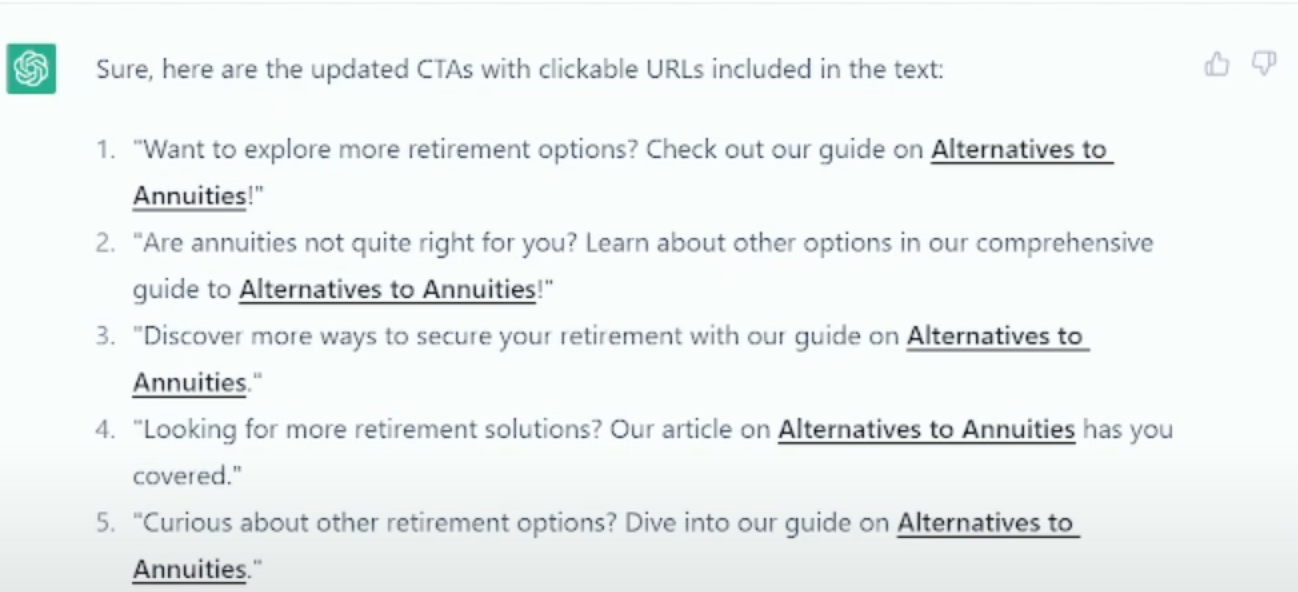
Generating blurbs with CTA backlinks using ChatGPT
Prompt: Write a blurb (including the keyword of the URL’s suffix as an H2 header), making sure to link to the appropriate keyword URL. Make sure to expand on the topics and make sure to have the links in the body of the text. Do NOT use “here” as an anchor tag. Include as internal links using markdown hyperlink keywords using links as the Ahref. There should be at least one internal link for each keyword listed. Use keyword-rich anchor text, making sure to list the keyword as the anchor text! Here are the list of URLs to use (each one spoken about in a separate H2 header):
It produces blurbs with CTAs that can drive readers to other pages on your website:
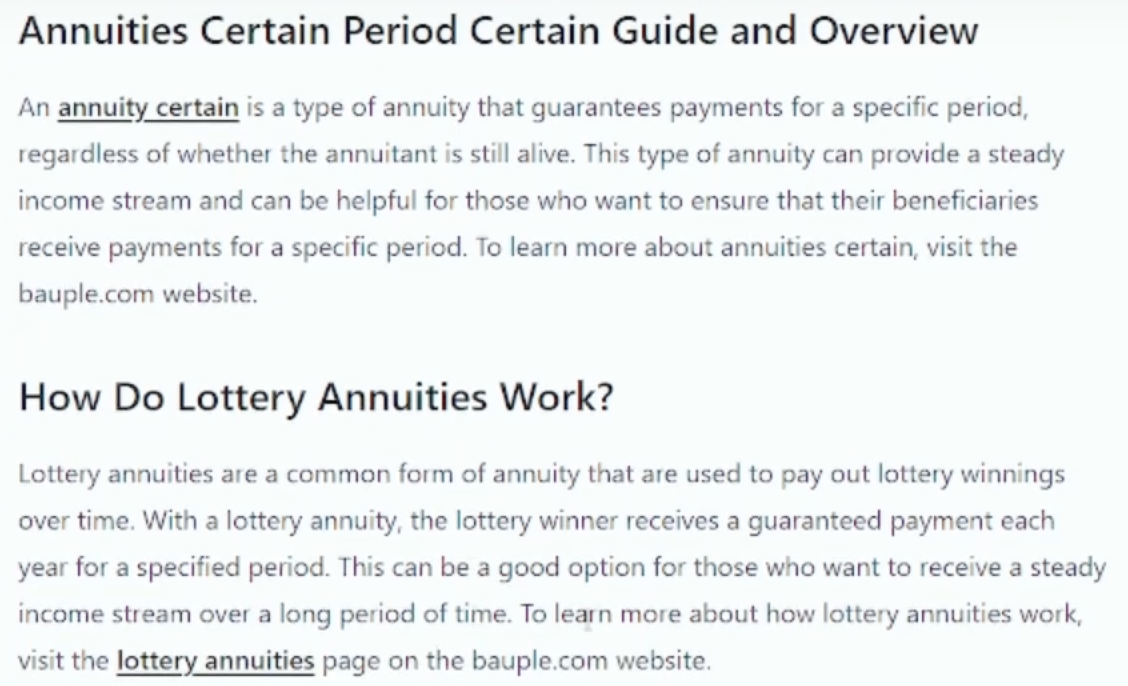
The man behind this prompt is Jesse Cunningham, an SEO expert who shares his strategies for boosting website traffic on his YouTube channel by the same name.
In this particular video, he showed an automated method for generating backlinks to a webpage. Backlinks are important because they count as votes of confidence for your web page, helping it in ranking better on a particular search engine.
Jesse has organized his articles into different tiers:
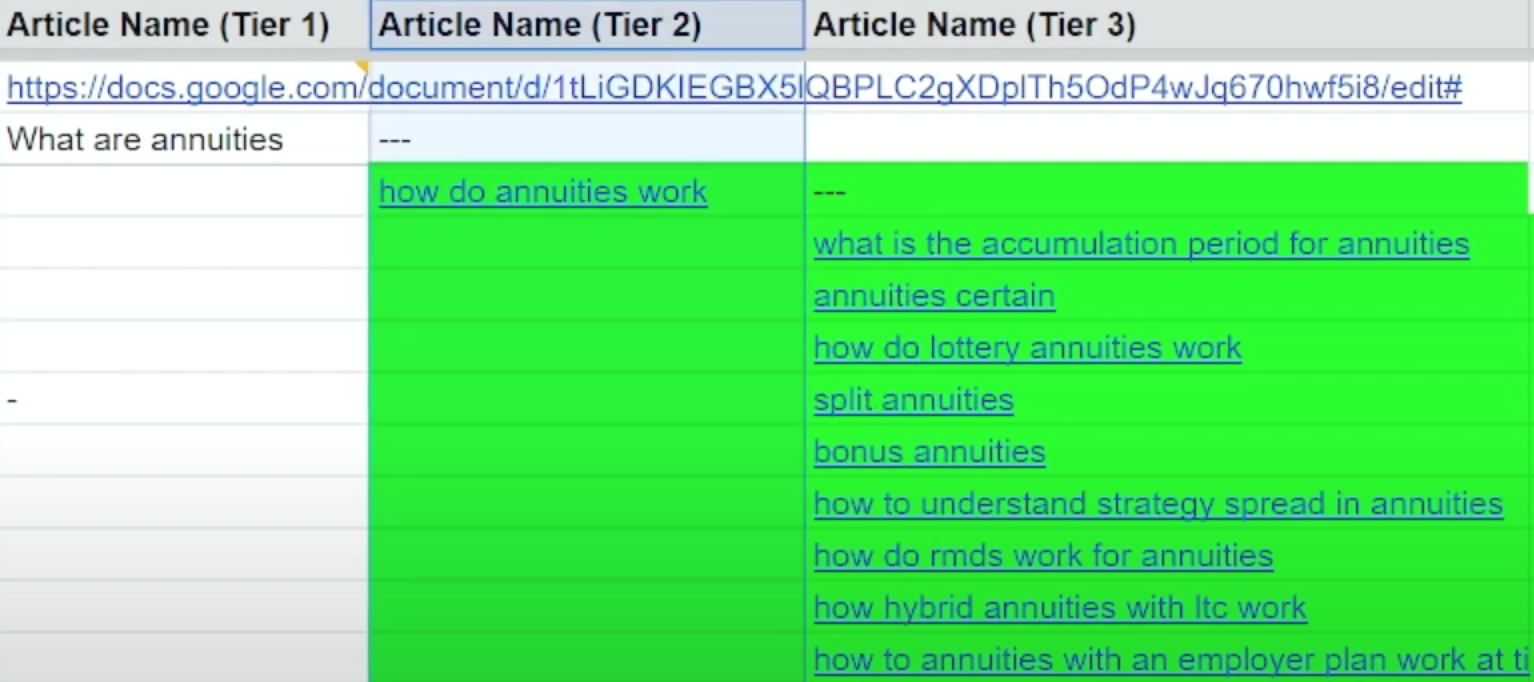
All Tier 3 articles link back to Tier 2 articles through an in-text CTA. But generating this CTA every time for a new article can be a hassle. Especially since it’s not really adding any value for the reader, and its only purpose is to redirect them to another article.
Now, this may not seem like a very significant workflow. However, bloggers are churning out tons of articles every day in order to stay relevant and attract more readers.
In fact, Jesse is also writing 1000 blog posts all through the end of 2023.
But if you still think writing a single line of text isn’t a problem, you should consider the blurbs. Now, if you had to generate a block of text for a single topic just to add a backlink, I imagine the work would quickly pile up.
And that’s where ChatGPT comes in. It generates CTAs (with backlinks) automatically. It can also generate blurbs, and it can make your life easier, all while helping drive more traffic to your blog. But of course, not everything is as easy as it seems, and I will tell you why.
Limitations and possible improvements
ChatGPT doesn’t always understand you: Jesse didn’t get the best results on his first run. As a matter of fact, he had to run several different prompts asking ChatGPT to fix the different errors. One of the most common errors was that ChatGPT added the link in a separate line of text and kept the actual CTA unlinked.

But Jesse fixed that with a quick prompt “make sure to have the links in the body of the CTA NOT outside”.
Similarly, when ChatGPT generated the blurbs, it added the backlink to the wrong anchor, “bauple.com”, instead of the keywords in the blurb.
But this was another quick fix with a (few) simple prompt(s).
Prompt: rewrite and make the anchor text pertain to the keywords of the specific H2 you are writing
If that doesn’t work, you go with another prompt.
Prompt: Rewrite and make sure to have the clickable links with the words that are the keywords of that H2
And eventually, it will figure it out:
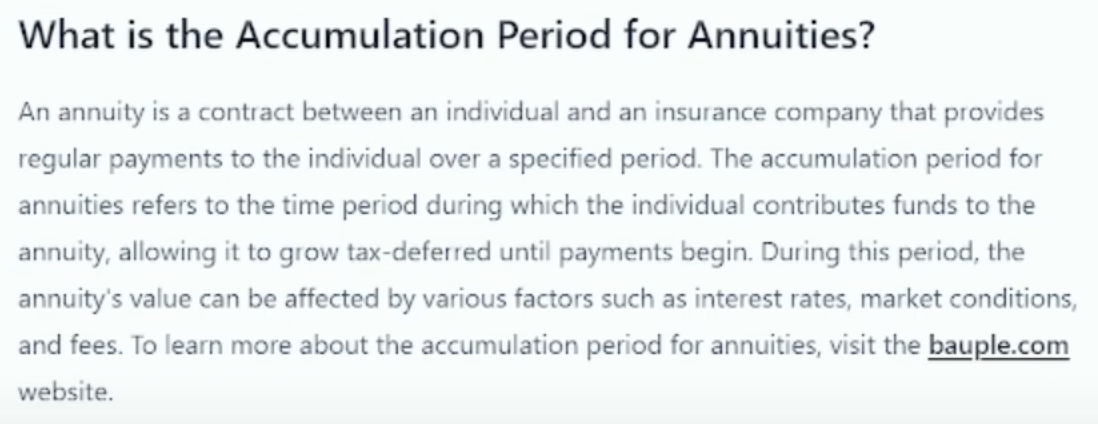
Jesse’s prompt is hard to read: I don’t know about you guys, but I really struggled with trying to understand Jesse’s prompt. I mean, it’s one thing replacing two parameters and another thing trying to really make sense of the prompt so that you can modify it to fit exactly your needs. So, I figured that I could probably replicate Jesse’s workflow with a simpler prompt - and I managed to do that with three simple prompts.
Prompt: I want you to create CTAs for the URLs below in the following style: “You may also like: [create clickable links using the title of the article in the URL”.
URL 1
URL 2
But that didn’t quite work. So, I asked it to redo it with a few more instructions.
Prompt: No, make these clickable links using markdown hyperlinking and put the clickable CTA links in text
And that worked great:

But I also wanted to get CTAs, so for that, I used an additional prompt.
Prompt: Great! Now write innovative CTAs for these links, which can be used to redirect the reader to these articles once they are done reading the main text
And that created the CTAs beautifully:
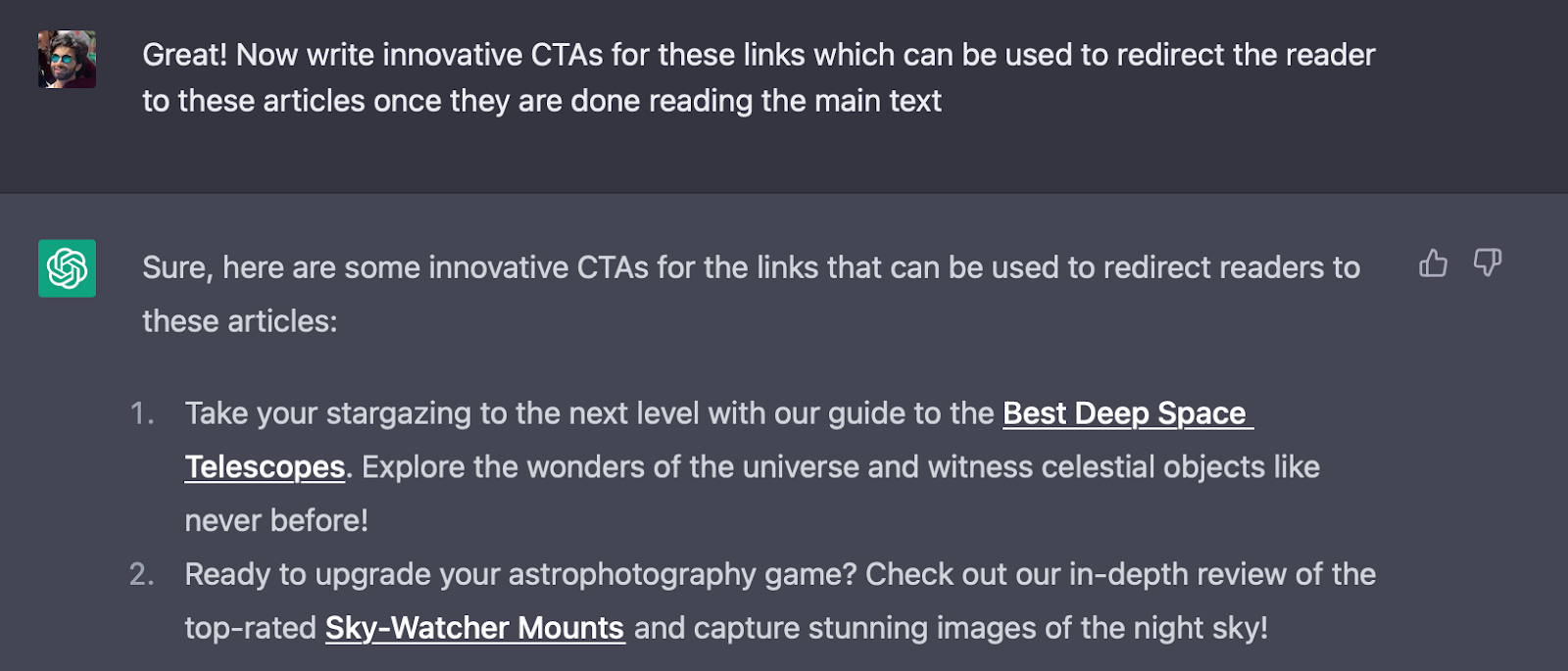
However, if you want a more descriptive CTA, you should go with the blurb prompt. It creates decent short paragraphs, and for me, it worked on the first try without any additional prompting.
If you are interested in learning more about Jesse’s prompts, check out his video:
Optimizing the blog writing process of ChatGPT
At this point, it’s fairly common knowledge that you can use generative AI to write big chunks of text or even entire documents. But usually, the output needs to be tweaked to make it sound more logical.
However, with this series of prompts, you might be able to optimize the text generation capacity of ChatGPT. And get some clicks on it pretty quickly (7 months, in this particular case).
Prompt 1: We’re going to write a 1500 word blog post answering the keyword ‘Are Labradors Smart’. Do you understand? Please don’t start writing yet.
Prompt 2: Excellent. First, can you please write me a list of keywords related to the target keyword ‘Are Labradors Smart’. We’re going to use them in the body of the blog post.
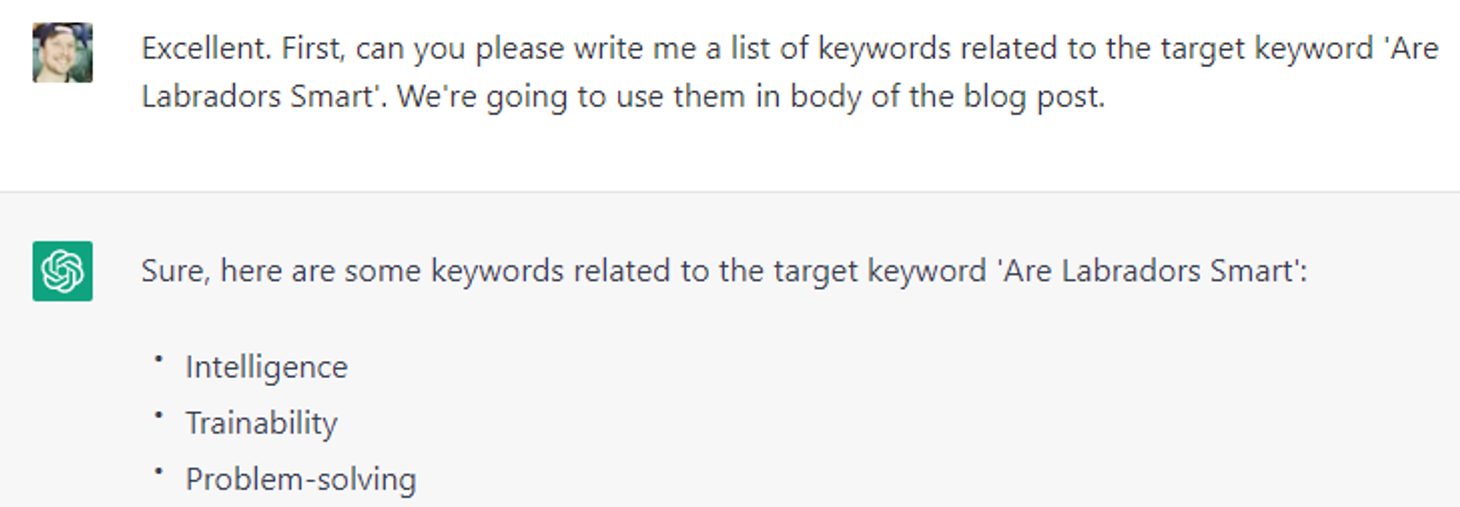
Prompt 3: Great! Next, I want you to please write the outline for a blog post answering the target keyword ‘Are Labradors Smart’. I want at least 5 H2 headings.
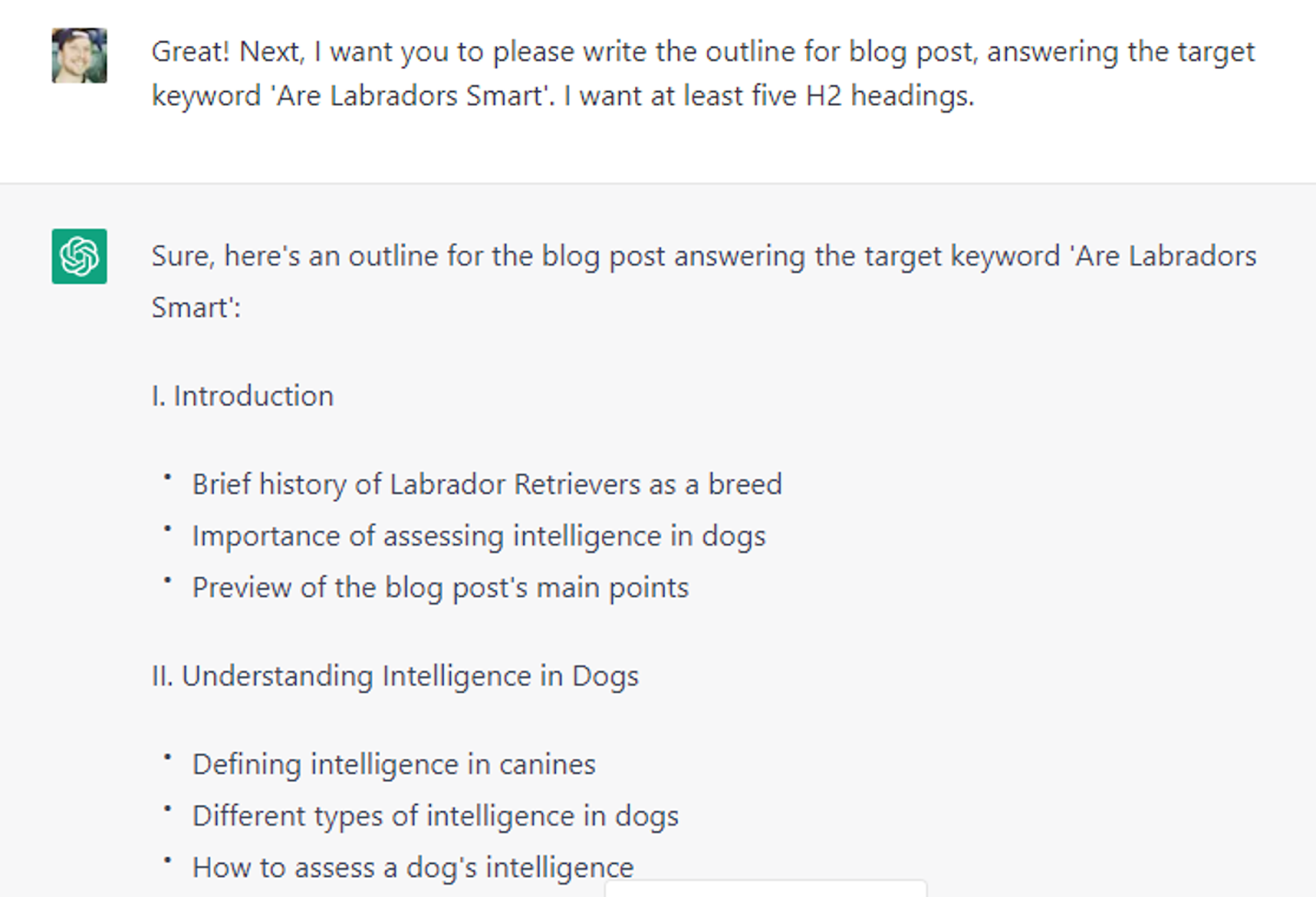
Prompt 4: Brilliant. Let’s start writing the blog post. Start by answering section I in detail, I want you to write as if you’re someone who has owned Labradors before. Write in a way that is both personal and informative.
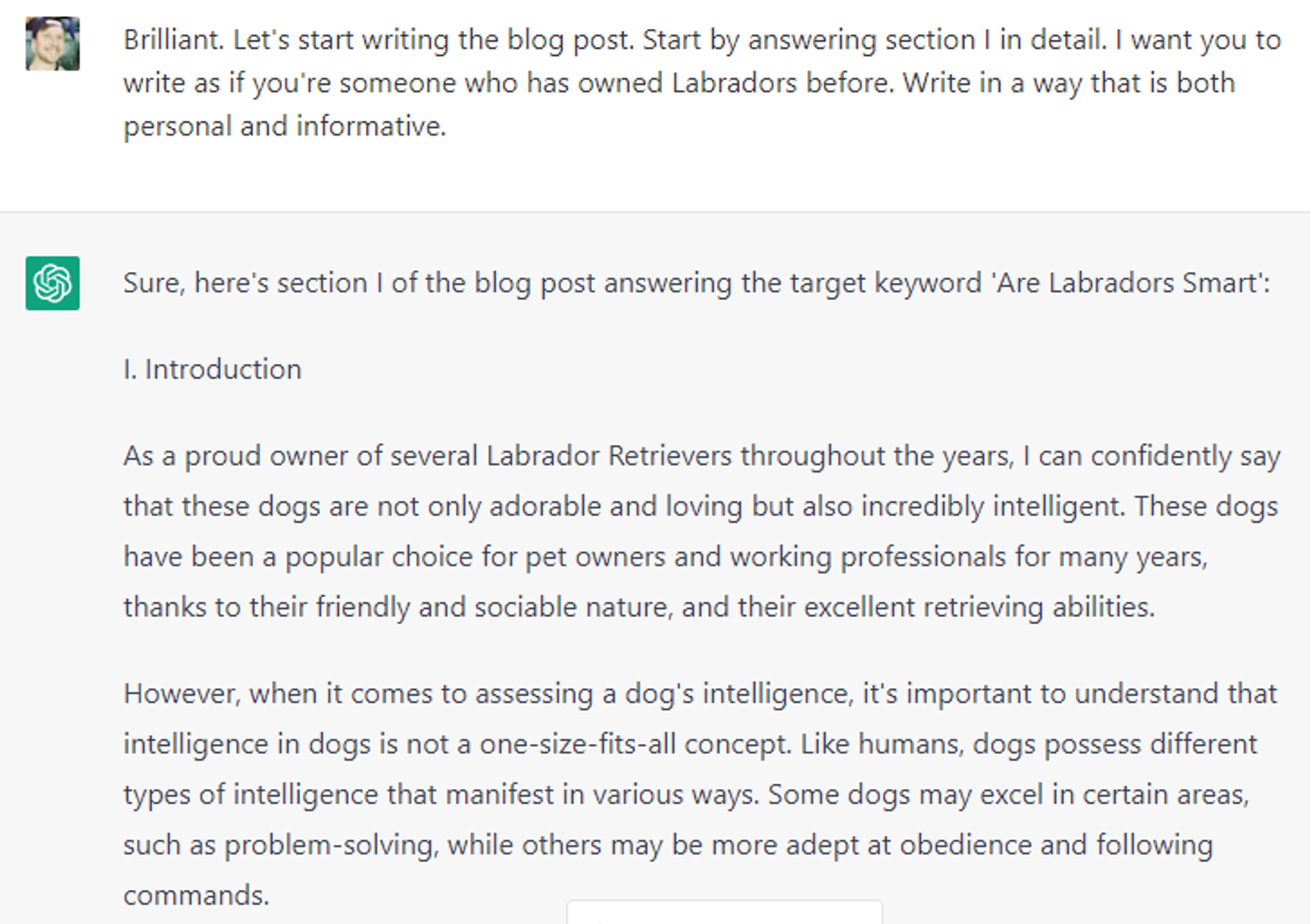
The credit for this workflow goes to Grades, who’s an up-and-coming SEO expert. He has been building a new website from scratch for the last seven months. Until the time he posted this, he had published 55 posts and gotten over 3.4k clicks for 198k impressions.
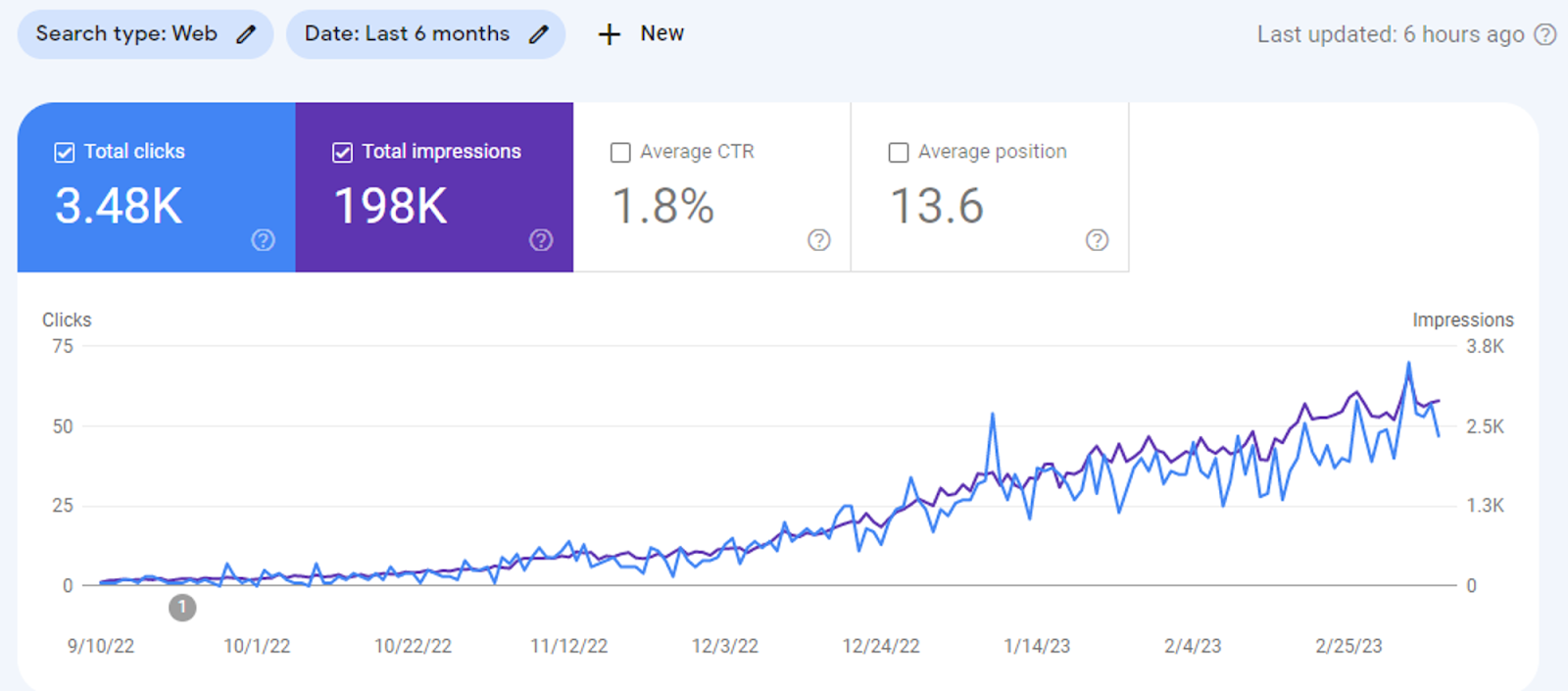
This gives him an average click-through rate (CTR) of 1.8%, which isn’t bad considering that the average organic CTR is usually 2%, and this is entirely AI-generated content.
Now, there’s not much difference in this workflow. You probably already do all of this, except the first prompt, which Grades calls “loading the prompt”.
Loading the prompt
Grades recommends providing ample information to ChatGPT before it begins writing. This can be done by “loading” the prompt, which means you give the AI a clear understanding of the topic and specific instructions about your requirements.
He claims that it helps in creating more logical, better outputs, but I personally don’t think it would matter that much. I am a medical writer, and I usually write about complex biological pathways, and recently I have been using ChatGPT to help a biotech firm launch its website.
I never load my prompts, and I still get the right results. Here’s what I got for a simple prompt without “prompt loading”:
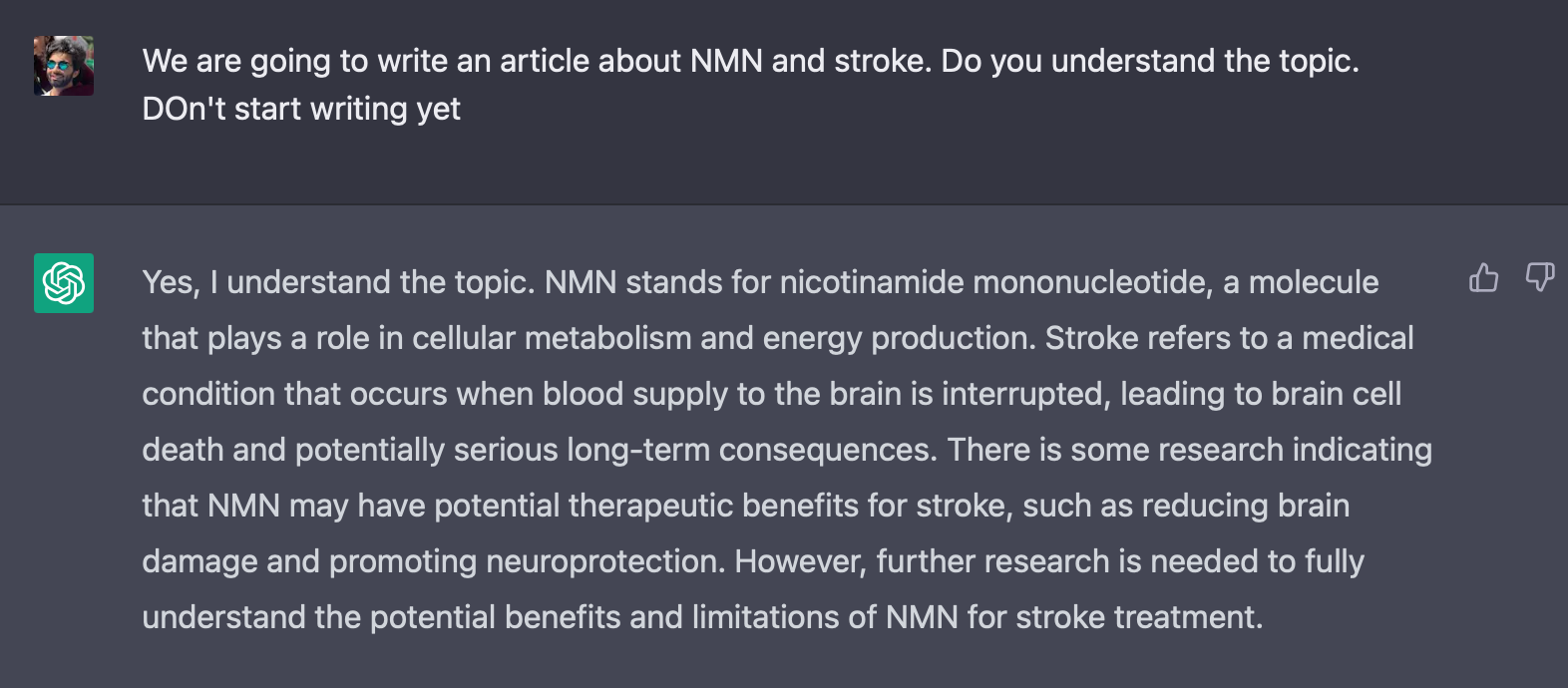
And here’s what I got after I did all the steps of Grace’s workflow:
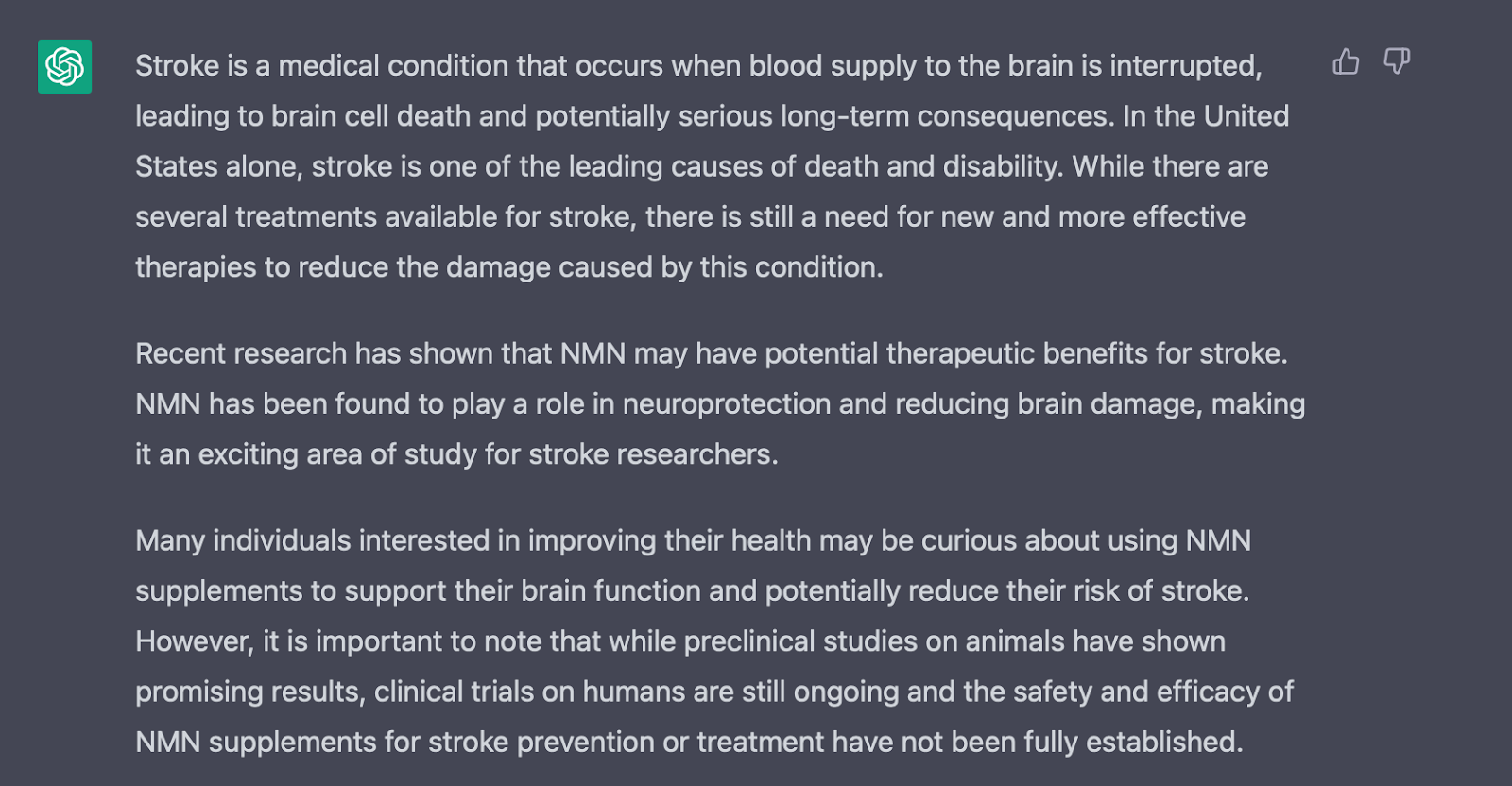
The only functional difference I see is that Grace’s prompts give a more detailed output. However, I can easily get the same by asking it to describe something in detail in the same prompt.
Therefore, personally, I don’t see how loading the prompts is improving anything, but they seem to be working for Grace.
Generating the outline and the content separately
One other thing that he does is he generates the outline first and then writes the blog using it. That’s something I can get behind because I do that too.
Now, it’s important that you generate the outline when you are working with detailed articles that need a lot of text.
Many of you may already be familiar with the fact that ChatGPT can’t generate a huge text-based output (if you are using the free version like me). So, you might need different prompts like the following to make it keep writing:

However, if you generate the outline separately, it really helps you understand what ChatGPT will be writing in each section. And then, you can tweak the outline to make it align much better with your needs.
Of course, that’s not all. You can also optimize the tone of the article and make it sound like the tone of your brand. But this is an added step.
Creating each section individually
When you are finally ready to write the article, Grades suggests that you ask ChatGPT to create each different section of the outline individually. Again, that’s something that I second because I have been using that too.
Plus, you can ask it to incorporate the different keywords into the text as you go. This helps in creating detailed sections of a blog that can be easily pieced together.
And you can repeat this section by section until your blog post is complete. Grades emphasized the importance of reminding ChatGPT about the tone of the post each time. Now, I don’t usually need to optimize the tone of my writing, so I am not really sure if this is required. However, if you have a specific brand voice, you can test it out.
Last but not least, always proofread your content. ChatGPT can provide helpful writing assistance, but it’s important to acknowledge that its output may not always be entirely accurate. In fact, a lot of times, its output might not even make sense.
And while Google allows AI-generated content now, it wants you to inject your human expertise into it. Proofreading and optimizing the content further could be one of those ways to add expertise to your text.
Therefore, to get the most out of the tool, it’s best to use it like a tool, not intended to replace the human input, but to make it better.
So, at the end of it, I am not sure if loading the prompt would help. However, the other two pieces of advice are definitely true. They can improve your writing, and I have been regularly using them long before I found Grade’s blog on how to optimize ChatGPT-written blogs.
However, whatever Grades is doing is working for him because he claims that he’s gotten his new website ranked in under seven months, and that’s pretty interesting.
If you would like to learn more about Grades’ entire workflow, you can check out his original post.
Creating blog posts from YouTube videos
Here’s a workflow that you can use to create blog posts using YouTube videos and ChatGPT. There are several different tools that are required for this entire workflow, but here’s the ChatGPT prompt:
Prompt: Create a creative, conversational summary. Pretend you are an expert in digital marketing and mention why you thought sharing this video would be valuable. Write a creator bio describing the creator and channel and include links. Make a list of key takeaways and quote the creator where applicable. Elaborate on each takeaway. Make a list of the resources mentioned. Pretend you are an expert in this niche and give your personal best advice. Add a FAQ with 5 questions and short answers. Do it for the following video transcript:
[paste video transcript]
And it creates something like this:
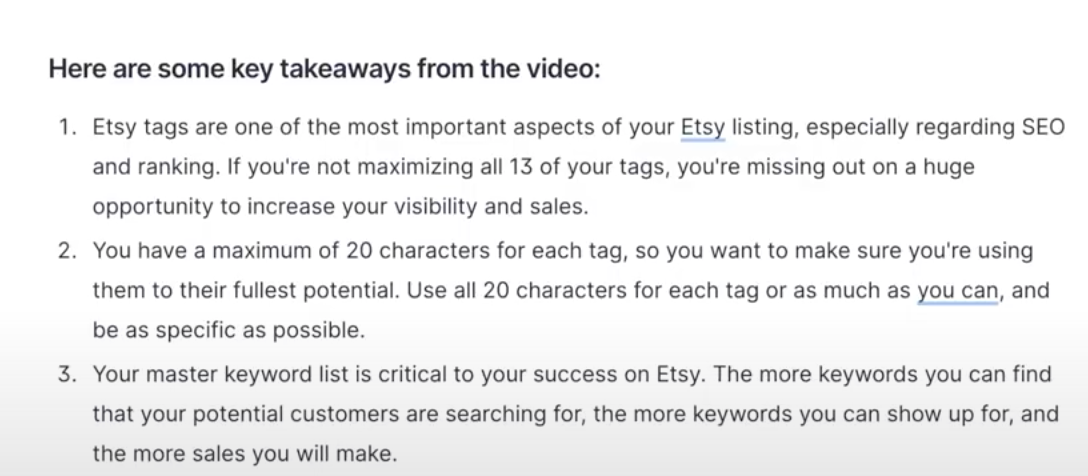
The person behind this workflow is Lori Ballen. She is a full-time affiliate marketer and SEO content writer who teaches other entrepreneurs how to get more leads and traffic.
She also has her own YouTube channel where she shared this workflow, which allegedly helped her blog get ranked within 24 hours.
Selecting a video
Now before we do this, we need to select a video to be converted into a blog post. It can be your own YouTube video or other people’s videos, provided they have a shareable license for you to embed it into your blog and give them their due credit.
Once you have selected the video, you will need a Chrome extension, YouTube Summary with ChatGPT. This extension creates a transcript and summary of the video.

On YouTube, it appears in the bottom right corner titled “Transcript & Summary”. By clicking the ChatGPT logo on it, it opens a new ChatGPT tab generating the summary.
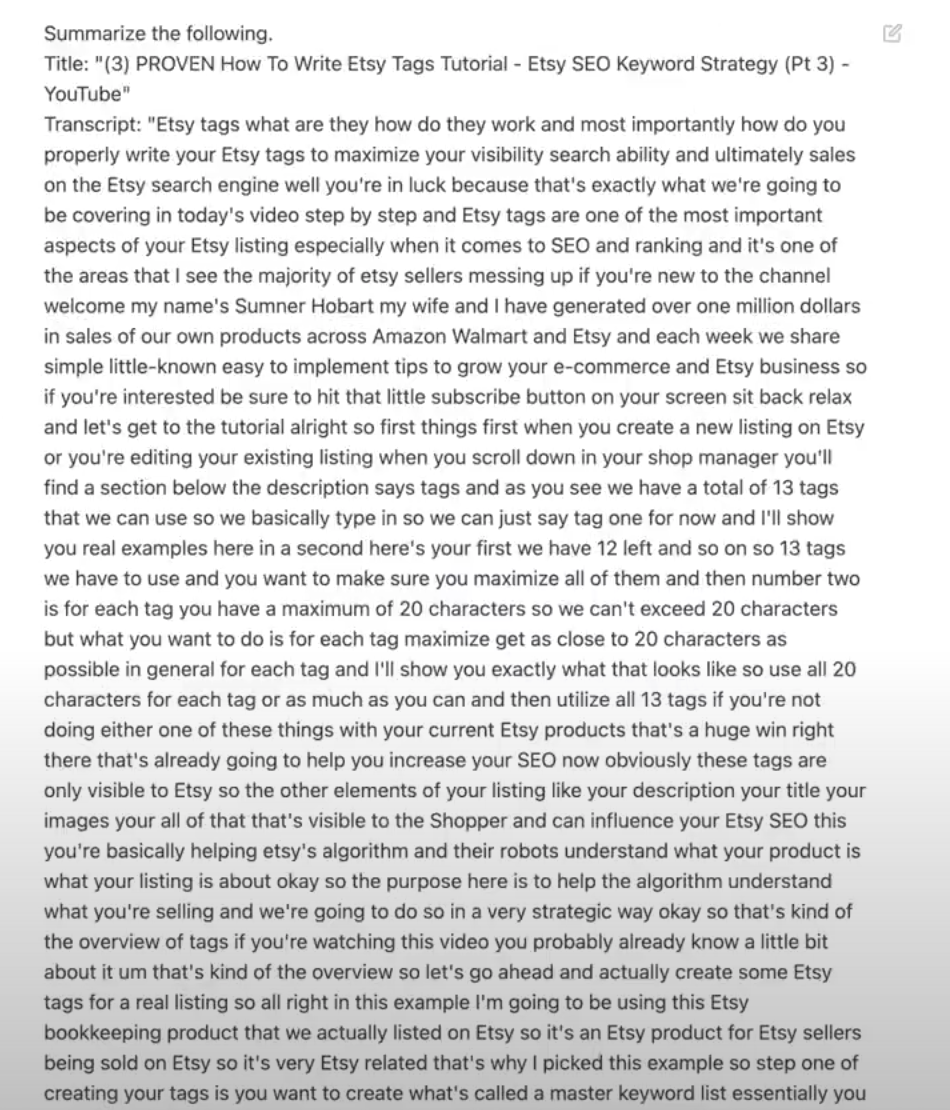
Converting the transcript into the article
As mentioned above, you can then proceed to use the prompt shared by Lori to different sections of the text from the video transcript. You can tweak this prompt based on your requirements.
At that point, you will have your article. Lori also had another brilliant idea - using AIPRM for ChatGPT. It’s a library of prompts where you can find her prompt and many others uploaded by people all over the world.
Moreover, you can use it to adjust the tone and writing style of the blog post. But obviously, you can do that by simply asking ChatGPT to adjust the tone too.
The AI controversy
Now one of the surprising steps in her video was using an AI-content detector despite the fact that Google now allows AI-generated content.
She used Originality.AI to detect the AI score percentage. (Fun fact: I was actually hired by the team behind Originality to test their tool and determine if it’s a good tool for AI content detection. I played around a bit, and it seemed to be doing a decent job).
You might be wondering why she did that because it’s an added step. Well, Lori says that although Google permits AI-generated content provided it is valuable and edited by humans, she prefers to be more cautious.
Given how her article allegedly got ranked in 24 hours, perhaps it’s true that Google still prefers human-written content.
So, for the next step, Lori used Jasper. She formatted the text and made some revisions to the blog post. And she used Jasper to create the bio for both the author of the video and herself.
She says that by using the bios, these blogs become original posts. Lori says it’s not “stealing”, but rather retrieving a synopsis of the video. And since we are taking videos of experts in their fields, it’s that infusion of “experience” that Google wants in AI-generated content.
Therefore, essentially, at the end of this process, you get an article that passes all of Google’s checks for getting ranked. And, of course, you can optimize it further using SEO tools like Surfer SEO.
Even if this doesn’t count as the expertise that Google is looking for, it’s still a cool way of creating blogs, especially on topics that you might not be well-versed in. Or even for creating how-to blogs.
All-in-all, if this workflow actually works, it’s a very innovative way of automating the “expertise” that Google wants in its ranked content. However, since Lori didn’t share any analytics, it’s hard to determine the validity of the claim.
Conclusion
While AI has undoubtedly made content creation easier and more efficient, it is not without its drawbacks. One of the biggest concerns with using AI in blogging is the potential for inaccuracies.
While AI algorithms have improved significantly over the years, they are still not perfect and can make mistakes that a human would easily catch.
Additionally, the time taken to fact-check AI-generated content can be significant, especially for bloggers who publish a large volume of content.
Despite these drawbacks, the benefits of using AI in blogging cannot be denied. By using AI tools for interlinking, content generation, and blog creation from videos, bloggers can save time and resources while still producing high-quality content.
As AI technology continues to evolve, it will be interesting to see how bloggers continue to integrate it into their content creation process.